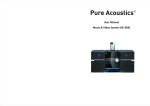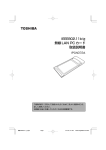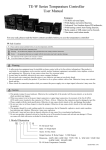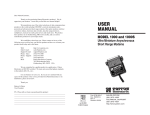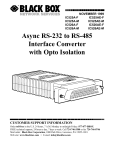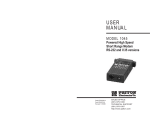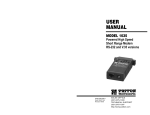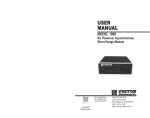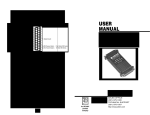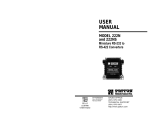Download Black Box Multi-Function Line Driver Specifications
Transcript
ME670A Multi-Function Line Driver, DB25 Black Box TABLE OF CONTENTS 1. Overview ...........................................................................................................5 1.1 Features ................................................................................................5 1.2 Description ............................................................................................5 2. Configuration ....................................................................................................6 2.1 Configuration Switches .........................................................................6 2.2 Configuration Switch Settings ...............................................................7 2.3 Switch Set SW1 ....................................................................................7 SW1 through SW-4: Data Rate Setting ..............................................7 SW1-5 and SW1-6: Clock Source ......................................................8 SW1-7: Anychronous/Synchronous Mode ..........................................8 SW1-8: Carrier Control Method ..........................................................8 2.4 Switch Set SW2 ....................................................................................9 SW2-1 and SW2-2: Word Length .......................................................9 3. Installation .......................................................................................................10 3.1 Connection to the Twisted Pair Interface ............................................10 Twisted Pair Connection Using RJ-11 OR RJ-45 .............................10 Twisted Pair Connection Using Terminal Blocks ..............................11 3.2 Connection to the RS-232 Interface ...................................................15 Connection to a “DTE” Device ..........................................................15 Connection to a “DCE” Device ..........................................................15 4. Operation ........................................................................................................17 4.1 Front Panel Switches ..........................................................................17 4.2 LED Status Monitors ...........................................................................17 4.3 V.54 Test Modes .................................................................................17 Local Analog Loopback (LAL) ...........................................................17 Remote Digital Loopback (RDL) .......................................................18 Using the V.52 BER Test Independently ..........................................18 4.4 Power-Down .......................................................................................19 A. Compliance ....................................................................................................20 A.1 EMC ....................................................................................................20 A.2 Low Voltage Directive (Safety) ............................................................20 A.3 Radio and TV Interference (FCC Part 15) ...........................................20 A.4 CE Declaration of Conformity ..............................................................20 B. Black Box ME670A Specifications .................................................................21 C. Black Box ME670A ........................................................................................22 D. Black Box ME670A Block Diagram ................................................................23 Page 2 724-746-5500 | blackbox.com RADIO FREQUENCY INTERFERENCE STATEMENTS FEDERAL COMMUNICATIONS COMMISSION AND INDUSTRY CANADA RADIO FREQUENCY INTERFERENCE STATEMENTS This equipment generates, uses, and can radiate radio-frequency energy, and if not installed and used properly, that is, in strict accordance with the manufacturer’s instructions, may cause interference to radio communication. It has been tested and found to comply with the limits for a Class A computing device in accordance with the specifications in Subpart B of Part 15 of FCC rules, which are designed to provide reasonable protection against such interference when the equipment is operated in a commercial environment. Operation of this equipment in a residential area is likely to cause interference, in which case the user at his own expense will be required to take whatever measures may be necessary to correct the interference. Changes or modifications not expressly approved by the party responsible for compliance could void the user’s authority to operate the equipment. This digital apparatus does not exceed the Class A limits for radio noise emission from digital apparatus set out in the Radio Interference Regulation of Industry Canada. Le présent appareil numérique n’émet pas de bruits radioélectriques dépassant les limites applicables aux appareils numériques de la classe A prescrites dans le Règlement sur le brouillage radioélectrique publié par Industrie Canada. 724-746-5500 | blackbox.com Page 3 Black Box 1. OVERVIEW This section provides a gerneral list of features and a description of the Black Box product. 1.1 FEATURES • Switch-selectable carrier control • Synchronous or asynchronous operation • No AC power or batteries required • Data rates to 38.4 Kbps • Distances to 12 miles (19.2 km) • Point-to-point or multipoint operation • Full or half duplex operation • Internal, external or received loopback clocking • V.54 loopback tests and V.52 compliant BER tests • Automatic equalization • Easy-to-read status LEDs • Transformer isolation • Silicon Avalanche Diode surge protection 1.2 DESCRIPTION The ME670A carrier controlled short range modem supports synchronous and asynchronous data rates to 38.4 Kbps. Requiring no AC power or batteries, the ME670A supports distances to 12 miles over unconditioned twisted pair. The ME670A features front panel LEDs, automatic equalization, V.52 compliant BER tests, both internal and external clocking and V.54 loopback tests. Built-in transformer isolation and surge protection provide protection against ground potential differences and AC/DC over-voltages. The ME670A is fully compatible with the Black Box Model ME475A-R2. This compatibility allows you to combine miniature, standalone and rack mounted modems in a single system. Page 4 724-746-5500 | blackbox.com Configuration Housed in an ABS plastic case, the ME670A comes with either a male or female DB25 connector and both an RJ-11/RJ-45 combo jack and terminal blocks with strain relief. The combo jack is pre-installed. 2. CONFIGURATION The ME670A is simple to install and is ruggedly designed for excellent reliability: just set it and forget it. The following instructions will help you set up and install the ME670A properly. If you have any questions, don’t hesitate to call Black Box Technical Support at (724) 746-5500 or email to [email protected]. 2.1 CONFIGURATION SWITCHES The ME670A uses a unique set of sixteen external DIP switches that allow configuration to an extremely wide range of applications. These DIP switches are grouped into two eight-switch sets and are externally accessible from the underside of the ME670A (see Figure 1). There is no need to open the ME670A’s case for configuration. The configuration switches allow you to select data rates, clocking methods, V.52 & V.54 tests, word lengths, extended signaling rates, asynchronous or synchronous mode and 2- or 4-wire mode. The drawings, text and tables on the following pages describe all switch locations, positions and functions. 1 2 3 4 5 6 7 8 1 2 3 4 5 6 7 8 OFF OFF SW1 SW2 Figure 1. The back of the ME670A 724-746-5500 | blackbox.com Page 5 Black Box 2.2 CONFIGURATION SWITCH SETTINGS The ME670A has two sets of eight switches, yielding 16 total DIP switches. The two sets will be referred to as SW1 and SW2. As Figure 2 shows, the orientation of all DIP switches is the same with respect to “ON” and “OFF” positions. ON DHS-8 1 2 3 4 5 6 7 8 OFF OFF Figure 2. Close up of cofiguration switches 2.3 SWITCH SET SW1 The DIP switches on SW1 set data rate, clock source, async./sync. mode and carrier control method. The default settings are summarized in the table below. Table 2. SW1 Summary Table Position Function SW1-1 SW1-2 SW1-3 SW1-4 SW1-5 SW1-6 SW1-7 SW1-8 Data Rate Data Rate Data Rate Data Rate Clock Source Clock Source Async./Sync. Carrier Control Factory Default On Off Off On On On On Off 9,600 bps Internal Async, Constantly On SW1 through SW-4: Data Rate Setting Switches SW1-1 through SW1-4 are set in combination to determine the asynchronous and synchronous data rate for the ME670A. Table 3: Data Page 6 Rate Setting SW1-1 SW1-2 SW1-3 SW1-4 Setting (Kbps) On Off On On On On On On 1.2 1.8 724-746-5500 | blackbox.com Configuration Table 3: Data Rate Setting SW1-1 SW1-2 SW1-3 SW1-4 Setting (Kbps) On Off On Off On Off On Off On Off Off On On Off Off On On On On On Off Off Off Off Off On On On On On On On On Off Off Off 2.4 3.6 4.8 7.2 9.6 14.4 19.2 28.8 38.4 SW1-5 and SW1-6: Clock Source Switches SW1-5 and SW1-6 are set in combination to determine the clock source for the ME670A. Table 4: Clock Source SW1-5 SW1-6 Setting On Off On On On Off Internal Transmit clock Receive Recover Clock External Transmit Clock SW1-7: Anychronous/Synchronous Mode The setting for switch SW1-7 determines whether the ME670A is in asynchronous or synchronous operating mode. Table 5: Anyc./Sync. Mode SW1-7 Setting On Off Anychronous Synchronous SW1-8: Carrier Control Method The setting for switch SW1-8 determines whether the carrier is “constantly on” or “controlled by RTS”. This setting allows for operation in switched carrier, multipoint and/or 724-746-5500 | blackbox.com Page 7 Black Box hardware handshaking applications. Note: SW1-8 must be “ON” in all 2-wire applications. Table 6: Carrier Control Method SW1-8 Setting Off On Constantly on Controlled by RTS 2.4 SWITCH SET SW2 The DIP switches on SW2 set word length, extended signaling rate, RTS/CTS delay, 2-wire/4-wire and V.52/V.54 tests. The factory default settings for Switch Set SW2 are summarized in the table below. Table 7: SW2 Summary Table Position Function SW2-1 SW2-2 SW2-3 SW2-4 SW2-5 SW2-6 SW2-7 Word Length Word Length Extended Signaling RTS/CTS Delay RTS/CTS Delays 2/4 Wire 2/4 Wire Off Off Off On On On Off Factory Default SW2-8 V.52/V.54 Tests Off 10 bits -2.5% to +1% 7 mS 4-wire/ full dpx Enabled SW2-1 and SW2-2: Word Length SW2-1 and SW2-2 are set in combination to determine the word length for aynchronous data. Table 8: Word Page 8 Length SW2-1 SW2-2 Setting (bits) Off On Off On On On Off Off 8 9 10 11 724-746-5500 | blackbox.com Installation 3. INSTALLATION Once the ME670A is properly configured, it is ready to connect to your system. This section tells you how to connect the ME670A to the twisted pair and RS-232 interfaces. 3.1 CONNECTION TO THE TWISTED PAIR INTERFACE The ME670A supports data-only communication between two RS-232 devices at distances to 12 miles (19.2) and data rates to 38.4 Kbps. There are two essential requirements for installing the ME670A: • These units work in pairs. Therefore, you must have one ME670A (or a compatible model) at each end of a two twisted pair interface. • To function properly, the ME670A needs two twisted pairs of metallic wire. These pairs must be unconditioned, dry, metallic wire, between 19 and 26 AWG (the higher number gauges may limit distance somewhat). Standard dial-up telephone circuits or leased circuits that run through signal equalization equipment are not acceptable. Twisted Pair Connection Using RJ-11 OR RJ-45 The RJ-11/RJ-45 combo jack connectors on the ME670A's twisted pair interface are pre-wired for a standard TELCO wiring environment (see Figure 3). The signal/pin relationships are shown on the table on the following page. 1- No Contact 2 - Blue 3 - Yellow 4 - Green 5- Red 6 - Black 7 - White 8 - No Contact Figure 3. RJ-11/RJ-45 Combo Jack Note Both RJ-11 and RJ-45 plugs will insert into the jack, shown in Figure 3. 724-746-5500 | blackbox.com Page 9 Black Box Table 9. Plug Wiring RJ-11 Signal RJ-45 Signal 1 2 3 GND* RCV* XMT 1 2 3 N/C GND* 4 5 6 XMT RCV GND* 4 5 6 7 8 RCVXMT XMT RCV GND* N/C Figure 4. Inserting flathead screwdriver Twisted Pair Connection Using Terminal Blocks If your application requires you to connect two pairs of bare wires to the ME670A, you must open the case to access the terminal blocks. For your convenience, the ME670A comes standard with a RJ-11/RJ-45 combo jack and a terminal block with strain relief. The instructions on the following pages will tell you how to open the case, connect the bare wires to the terminal blocks and fasten the strain relief collar in place so that the wires won't pull loose. 1. Open the unit by gently inserting a flathead screwdriver into the special pry slot on the plastic case (below). Don't worry about breaking the plastic, but make sure that you do not insert the screwdriver more than 1/4” into the enclosure, as you may damage the unit.Once the unit has been opened, you will be able to see the terminal blocks located at the rear of the PC board. Page 10 724-746-5500 | blackbox.com Installation Figure 5. ME670A opened Strip the outer insulation from the twisted pairs about one inch from the end. Figure 6. Twisted pair pre-modification Figure 7. Strip back the insulation on each of the 2 twisted pair wires about.25”. Figure 8. Twisted pair wires post modefication 2. Connect one pair of wires to the two XMT (transmit) poles on the terminal block. The ME670A is not polarity sensitive, so either wire may connect to either pole. 724-746-5500 | blackbox.com Page 11 Black Box 3. Connect the other pair of wires to the two RCV (receive) poles on the terminal block. Ultimately, you will want to construct a two-pair crossover cable that makes a connection with the two ME670As as shown below: Table 10: Two-pair XMT XMT G RCV RCV Crossover Cable Connections To Shield (Optional) RCV RCV G XMT XMT One Pair One Pair 4. If there is a shield around the telephone cable it may be connected to “G” on the terminal block. To avoid ground loops, we recommend connecting the shield at the computer end only. A ground wire is not necessary for proper operation of the ME670A. 5. When you finish connecting the wires to the terminal block, the assembly should resemble the diagram below: XMT G RCV Figure 9. Two-Pair Crossover Cable Connection Diagram 6. Place the 2 halves of the strain relief assembly on either side of the telephone wire and press together very lightly. Slide the assembly so that it is about 2 inches from the terminal posts and press together firmly. If your cable diameter Page 12 724-746-5500 | blackbox.com Installation is too small or too large for our strain relief, please contact our technical support. We have strain relief assemblies to accommodate most cable diameters. XMT G RCV Figure 10. Strain Relief Diagram 7. Insert the strain relief assembly with the wire going through it into the slot in the bottom half of the modem case and set it into the recess in the case. XMT G RCV Figure 11. Recess Case with Strain Relief Assembly Diagram 8. Bend the top half of the case as necessary to place it over the strain relief assembly. Do not snap the case together yet. Figure 12. Closing ME670A Chassis 724-746-5500 | blackbox.com Page 13 Black Box 9. Insert one captive screw through a saddle washer, then insert the entire piece through the hole in the DB-25 end of the case. Snap that side of the case closed. Repeat the process for the other side. This completes cable installation. 3.2 CONNECTION TO THE RS-232 INTERFACE Once you have connected the twisted pair wires correctly, simply plug the ME670A directly into the DB-25 port of the RS-232 device. After doing so, remember to insert and tighten the two captive connector screws. Connection to a “DTE” Device The ME670A is wired as a DCE, and therefore “wants” to plug into a DTE such as a terminal, PC or host. Because the ME670A is interface powered, a direct connection to the RS-232 DTE port is most desirable. If you must use a cable to connect the ME670A to the DTE port, make sure it is a straight through cable of the shortest possible length—we recommend 6 feet or less. Connection to a “DCE” Device Since the ME670A is wired as a DCE, you cannot connect it directly to another DCE such as a modem, multiplexer or printer. If you need to connect the ME670A to another DCE device, you must use a null modem cable wired according to diagram below. We recommend a cable of the shortest possible length, preferably 6 feet or less. Table 11: DCE Note Page 14 Device Connection Connection to ME670A DB-25 Pin No. Connection to DCE Device DB-25 Pin No. 1 2 3 4 8 6 20 17 24 7 1 3 2 8 4 20 6 24 17 7 When connected to another DCE deice, the ME670A should be configured for “external clock” (see “Switch Set SW1” on page 6) 724-746-5500 | blackbox.com Installation BERT LOOP 511/RDL NORMAL 511 LAL ME670A Multi-Function Line Driver S/N 123456 Figure 13. ME670A’s LED indicators and test switches 724-746-5500 | blackbox.com Page 15 Black Box 4. OPERATION Once the ME670A is properly configured and installed, it should operate transparently—as if it were a standard cable connection. Operating power is derived from the data and control signals; there is no “ON/OFF” switch. This chapter describes reading the LED status monitors, powering-up and using the built-in V.52 and V.54 test modes. 4.1 FRONT PANEL SWITCHES During normal operation, both front panel switches should be in the “normal” center position. To operate a test mode, see “V.54 Test Modes” on page 16. 4.2 LED STATUS MONITORS The ME670A features 2 front panel LEDs that indicate the condition of the V.52 and V.54 test modes. figure 13 on page 15 shows the location of each LED. “V.54 Test Modes” describes each LED’s function in more detail. 4.3 V.54 TEST MODES The ME670A offers two V.54 test modes to evaluate the condition of the modems and the communication link. These tests can be activated physically from the front panel, or via the RS-232 interface. Note: V.54 test modes on the ME670A are available for point-to-point and 4-wire applications only. Local Analog Loopback (LAL) The Local Analog Loopback (LAL) test checks the operation of the local ME670A, and is performed separately on each unit. Any data sent to the local ME670A in this test mode will be echoed (returned) back to the user device. For example, characters typed on the keyboard of a terminal will appear on the terminal screen. To perform a LAL test, follow these steps: 1. Activate LAL. This may be done in one of two ways: First, by moving the front panel toggle switch DOWN to “LAL”. Second, by raising pin 18 on the RS-232 interface (Note: Make sure DIP switch SW2-8 is OFF). Once LAL is activated, the ME670A transmit output is connected to its own receiver. The “test” LED should be lit. 2. Verify that the data terminal equipment is operating properly and can be used for a test. If a fault is indicated, call a technician or replace the unit. 3. Perform a BER (bit error rate) test on each unit. If the BER test equipment indicates no faults, but the data terminal indicates a fault, follow the manufacturer’s Page 16 724-746-5500 | blackbox.com Operation checkout procedures for the data terminal. Also, check the RS-232 interface cable between the terminal and the ME670A. Remote Digital Loopback (RDL) The Remote Digital Loopback (RDL) test checks the performance of both the local and remote ME670As and the communication link between them. Any characters sent to the remote ME670A in this test mode will be returned back to the originating device. For example, characters typed on the keyboard of the local terminal will appear on the local terminal screen after having been passed to the remote ME670A and looped back. To perform an RDL test, follow these steps: 1. Activate RDL. This may be done in two ways: first, by moving the front panel toggle switch UP to “RDL”. Second, by raising pin 21 on the RS-232 interface (Note: Make sure SW2-8 is OFF). 2. Perform a BER (bit error rate) test on the system. 3. If the BER test equipment indicates a fault, and the Local Analog Loopback test was successful for both ME670As, you may have a problem with the twisted pair line between the modems. Make sure you check the twisted pair line for proper connections and continuity. Using the V.52 BER Test Independently The V.52 BER test can be used independently of the V.54 loopback tests. This requires two operators: one to initiate and monitor the test at the local ME670A, and one at the remote ME670A. To use the V.52 BER test by itself, both operators should simultaneously follow these steps: 1. Locate the “511/511E” toggle switch on the front panel of the 1040 and move it DOWN. This activates the V.52 BER test mode and transmits a “511” test pattern to the other unit. If any errors are present, the receiving modem’s red “Error” LED will blink sporadically. Note: For this test to function, the “511” switch on both ME670As must be on. 2. If the test indicates no errors are present, move the V.52 toggle switch UP, activating the “511/E” test with periodic errors present. If the test is working properly, the receiving modem's red “Error” LED will light continuously. A successful “511/E” test will confirm that the link is in place, and that the ME670A’s built-in “511” generator and detector are working properly. 724-746-5500 | blackbox.com Page 17 Black Box 4.4 POWER-DOWN Turn off the ME670A by simply removing it from the circuit or by turning off the terminal that is directly connected to the ME670A. Page 18 724-746-5500 | blackbox.com Compliance A. COMPLIANCE A.1 EMC • FCC Part 15, Class A • EN55022, Class A • EN ETSI 300 386 V1.3.3 A.2 LOW VOLTAGE DIRECTIVE (SAFETY) • UL 60950-1/CSA C22.2 No. 60950-1 • IEC/EN60950-1 A.3 RADIO AND TV INTERFERENCE (FCC PART 15) This device generates and uses radio frequency energy, and if not installed and used properly-that is, in strict accordance with the manufacturer’s instructions-may cause interference to radio and television reception. The device has been tested and found to comply with the limits for a Class A computing device in accordance with specifications in Subpart B of Part 15 of FCC rules, which are designed to provide reasonable protection from such interference in a commercial installation. However, there is no guarantee that interference will not occur in a particular installation. If the device does cause interference to radio or television reception, which can be determined by disconnecting the unit, the user is encouraged to try to correct the interference by one or more of the following measures: moving the computing equipment away from the receiver, re-orienting the receiving antenna and/or plugging the receiving equipment into a different AC outlet (such that the computing equipment and receiver are on different branches). A.4 CE DECLARATION OF CONFORMITY Black Box, Corporation declares that this device is in compliance with the essential requirements and other relevant provisions of Directive 2004/108/EC relating to electromagnetic compatibility and Directive 2006/95/EC relating to electrical equipment designed for use within certain voltage limits. Contact [email protected] for a Declaration of Conformity. The safety advice in the documentation accompanying this device shall be obeyed. The conformity to the above directive is indicated by CE mark on the device. 724-746-5500 | blackbox.com Page 19 Black Box B. BLACK BOX ME670A SPECIFICATIONS Table 12. ME670A Specifications Transmission Format Sync. and asyn., full or half duplex Transmission Line Unconditioned twisted pair 19-26 AWG Clocking Internal, external, or receive loopback Interfaces EIA RS-232, CCITT V.24 Data Rates 1.2, 1.8, 2.4, 3.6, 4.8, 7.2, 9.6, 14.4, 19.2, 28.8, 34.4 Kbps (switch selectable) Isolation Minimum 1500 V RMS via isolation transformers Control signals Constantly “on” or controlled by RTS RTS/CTS Delay No delay, 7ms, 53ms Connectors DB-25 male or female on RS-232 side; RJ-11, RJ-45 or terminal block with strain relief on line side Power Supply None required; uses power from EIA data and control signals Surge Protection Compliant with IEC 801.5 level 2, 1kV Temperature Range 0-60 C (32-140 F) Altitude 0-15,000 feet Humidity 5 to 95% non-condensing Dimensions 3.0” x 2.1” x 0.81” (7.6 x 5.3 x 2.1 cm) Weight 2 oz. (56.7g) Page 20 724-746-5500 | blackbox.com Black Box ME670A C. BLACK BOX ME670A 724-746-5500 | blackbox.com Page 21 Black Box ME670A Block Diagram D. BLACK BOX ME670A BLOCK DIAGRAM 724-746-5500 | blackbox.com Page 22 ME670A version 1























